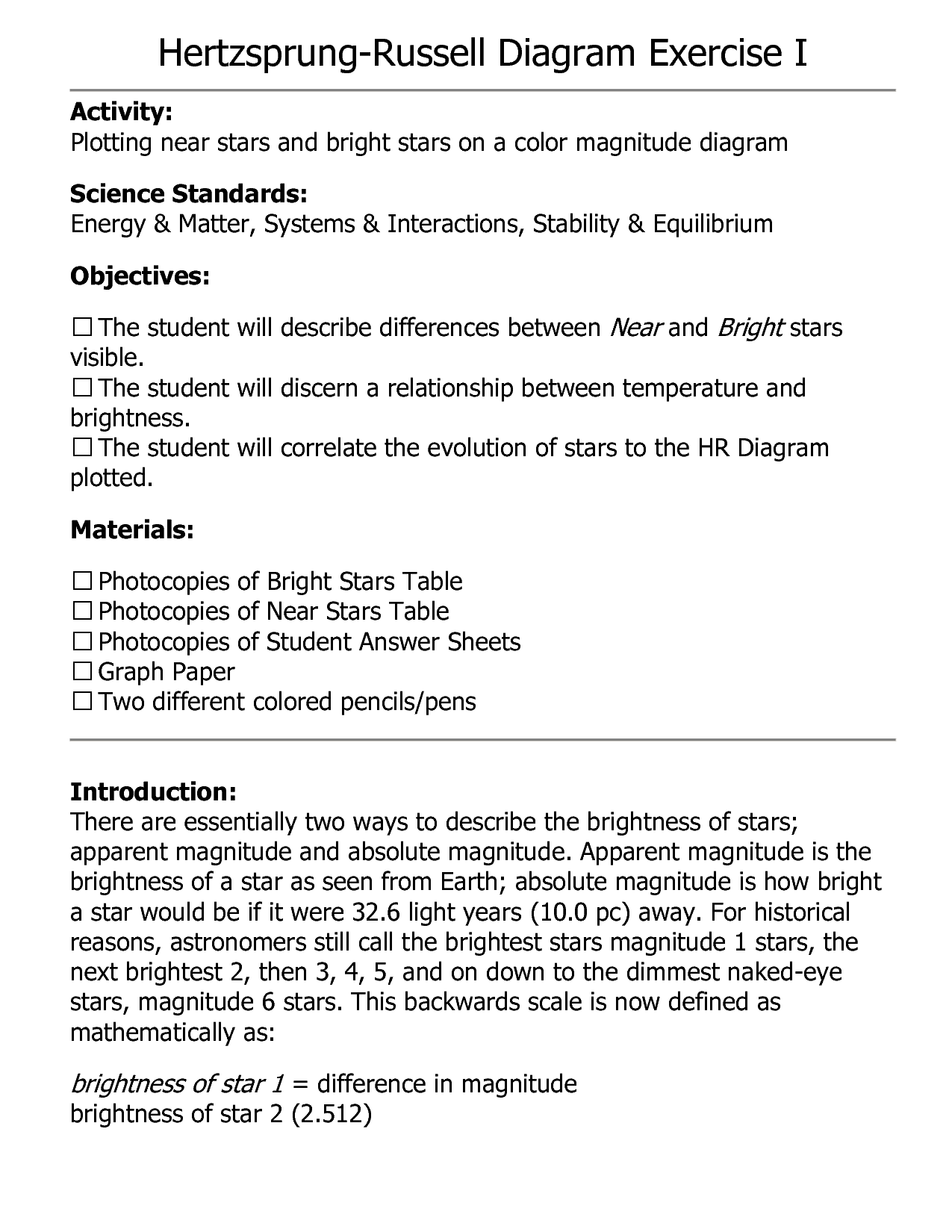Evolution of Stars Worksheet
The Evolution of Stars Worksheet is designed to provide an engaging and informative learning experience for astronomy enthusiasts of all levels. Whether you are a student looking to broaden your knowledge on stellar evolution or a teacher seeking a comprehensive resource to complement your lesson plans, this worksheet offers a perfect blend of entity and subject.
Table of Images 👆
More Other Worksheets
Kindergarten Worksheet My RoomSpanish Verb Worksheets
Cooking Vocabulary Worksheet
DNA Code Worksheet
Meiosis Worksheet Answer Key
Art Handouts and Worksheets
7 Elements of Art Worksheets
All Amendment Worksheet
Symmetry Art Worksheets
Daily Meal Planning Worksheet
What is stellar evolution?
Stellar evolution is the process by which a star changes over time, from its formation through to its death. It involves various stages such as the fusion of hydrogen into helium, expansion and contraction phases, and the eventual fate of the star as a white dwarf, neutron star, or black hole. The specific path a star takes in its evolution depends on its initial mass, and studying this process helps us understand the life cycle of stars and the formation of elements in the universe.
How do stars form?
Stars form from the gravitational collapse of dense regions within giant molecular clouds of gas and dust in space. As these regions collapse, the pressure and temperature increase, eventually igniting nuclear fusion reactions in their cores, turning them into stars. The balance between the force of gravity pulling material inward and the release of energy through fusion reactions allows stars to shine brightly and sustain themselves for millions or even billions of years.
What is the main sequence stage of a star's life cycle?
The main sequence stage of a star's life cycle is when it is fusing hydrogen into helium in its core, producing energy through nuclear reactions. This is the longest stage in a star's life, during which it remains stable and balanced as it burns its fuel to sustain its brightness and temperature.
How does a star's mass influence its evolution?
A star's mass greatly influences its evolution. Higher-mass stars have more gravity, resulting in higher temperatures and pressures, allowing for faster nuclear fusion reactions that lead to a shorter lifespan. These stars can eventually evolve into red supergiants, then explode in a supernova or collapse into a neutron star or black hole. On the other hand, lower-mass stars, like our Sun, have less gravity and fuse hydrogen into helium at a slower pace, leading to a longer lifespan as they evolve into red giants and eventually shed their outer layers to form planetary nebulae.
What happens when a star runs out of fuel?
When a star runs out of fuel, it can no longer sustain nuclear fusion reactions in its core, causing it to lose outward pressure and start collapsing under its own gravity. Depending on the mass of the star, different outcomes are possible: smaller stars, like our sun, will expand into a red giant before shedding their outer layers to form a planetary nebula and leaving behind a remnant core called a white dwarf; more massive stars may undergo a supernova explosion, leaving behind either a neutron star or a black hole.
What is a red giant?
A red giant is a type of star that is in a later stage of its evolution, characterized by its large size, low temperature, and red color. Red giants are formed when a star has exhausted its core hydrogen fuel and starts burning helium in its core. During this phase, the outer layers of the star expand and the star swells in size, making it one of the largest and brightest stars in the universe.
What is a supernova?
A supernova is a powerful and intense stellar explosion that occurs at the end of a star's life cycle. During a supernova, a massive star collapses under its own gravity and releases a tremendous amount of energy and radiation, creating an extremely bright and expanding shockwave that can outshine an entire galaxy for a short period of time. Supernovae play a crucial role in the formation of new elements and the dispersal of these elements into space, enriching the universe with heavy elements necessary for the formation of planets and life.
What is a white dwarf?
A white dwarf is a dense, compact stellar remnant that forms after a low to medium mass star exhausts its nuclear fuel and undergoes gravitational collapse. This results in a small and extremely hot core that is supported by electron degeneracy pressure. White dwarfs are incredibly dense, with masses comparable to the Sun but squeezed into a volume roughly the size of Earth. They gradually cool and fade over billions of years, eventually evolving into black dwarfs.
Can stars undergo multiple stages of evolution?
Yes, stars can undergo multiple stages of evolution. They form from clouds of gas and dust, then go through various stages such as the main sequence, red giant, and eventually can end their lives as supernovae, neutron stars, or black holes. Each stage represents different physical processes and changes in the star's structure and behavior as it progresses through its lifecycle.
How does the evolution of stars contribute to the formation of new elements in the universe?
The evolution of stars plays a crucial role in the formation of new elements in the universe through the process of nuclear fusion. Initially, stars fuse hydrogen into helium in their cores, releasing energy in the form of light and heat. As stars age and run out of hydrogen fuel, they start burning helium and successively heavier elements in their cores, producing elements like carbon, oxygen, and eventually even heavier elements like iron. When massive stars go supernova at the end of their life cycles, they release tremendous amounts of energy, further synthesizing even heavier elements like gold, silver, and uranium. These newly synthesized elements are then dispersed into space through stellar winds and supernova explosions, enriching the interstellar medium and contributing to the formation of new stars, planets, and life.
Have something to share?
Who is Worksheeto?
At Worksheeto, we are committed to delivering an extensive and varied portfolio of superior quality worksheets, designed to address the educational demands of students, educators, and parents.

































Comments